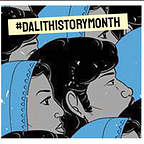The Namashudra Strike: When 800,000 Dalits stood strong
by Anita Das
Read the article in Hindi here.
Today in #DalitHistory, we honor the Namasudras of present day Bangladesh, who played a significant role in organizing and wielding the power of a unified Dalit action to improve their conditions.
For much of history, Namasudras maintained their own tribal identity in both of Hindu and Muslim majority regions. Like many other tribes, their communitywas also affected by Brahminisation which placed them outside the Caste system and vulnerable to othering and oppression. So, despite being adept at an indigenous life — boating, navigating waterways and fishing in seasons of rain — and agriculture in drier seasons, they were treated as “untouchables” by both oppressor caste Hindus and Muslims.
By the 1800s, many Namasudras were sick of the devaluation of their communities. They knew that services they provided were actuallly indispensable to the economy of their region. In 1873, they launched one of the largest Dalit movements for dignity, in the Faridpur district of Bangladesh.
It stared when in one of the villages, a Namasudra who had come into some wealth, Choron Sapah, decided to throw a feast inviting all members of society including Brahmins and Kayasthas. These oppressor castes Hindus were infuriated by the invitation to eat from a Dalit person’s household. To protest their perceived defamation, they hurled derogatory remarks at Namasudra women.
“Eat with men who permit their women to go to the market and who are employed in jails for removing filth? What next?!”
Namasudras did not like the attack on their women or the derogatory reference to the oppressive work they were forced into. They called a community-wide meeting and passed a resolution. All members of the community would refuse any of their labor to their oppressor caste masters. A strike was put into place.
Immediately local economies were impacted. Namasudras were agricultural hired labor for caste landlords. And when they stopped work, crops began failing. Boats were built, maintained and manned by Namasudras. Transportation in the region came to a grinding halt. No trade could occur because goods could not be transported. Markets suffered. People were left without food.
On hearing of the Namasudra Strike in Faridpur, all the local Dalit castes of neighboring Jessore and Barisal, joined in. Dalit prisoners went on strike, refusing to do the unclean work not given to “upper”-Caste prisoners.
As a result of their collective action, many landlords found themselves at the edge of starvation and loss.
The strike of almost 800,000 Dalits in three districts continued for six months.
Desperate landlords appealed to the local British magistrates for a resolution. And these Dalit worker strikes ended only when the English, along with the landlords, then passed official orders to prevent and penalize the mistreatment of Dalits.
This little known, little told story of an efficient, highly organized, and non-violent Dalit workers strike, of close to a million people, in 1873, is an incredible piece of history and testament to the power of collective action.
Anita Das is an independant researcher whose interests lay in caste and liberatory faith traditions.
